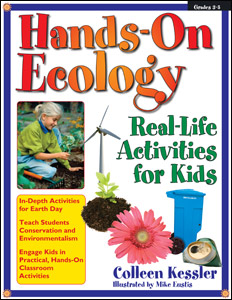Hands-On Ecology was written for traditional classrooms for grades three to five. Even though activities continually refer to classroom-size groups and school grounds, most activities can be easily adapted for a homeschooling family to use. In fact, some activities would be much more practical for a family than a classroom. The book is self-contained with all instructional information plus reproducible pages for students.
The book is divided into seven units with a number of activities in each unit. The first unit, titled “Preparing the Essentials,” will probably be the least interesting to students. It begins with creating an ecology dictionary and a journal. Personally, I’d print off the pages of the ecology dictionary and have students enter definitions when the words are pertinent to an activity rather than completing the four pages of definitions within a few days. It’s too boring an activity to use as a kick-off activity. As far as the journal which is also introduced in the “essentials,” students will use it throughout the course to keep track of their work. I would probably give each student a thin, three-ring binder in which to create it.
As part of the first unit, you will need to create an ecology toolkit. The book has you create a large kit for the class and smaller kits for each student. I think one family toolkit should work fine. Likewise, many of the activities have individual students or groups of students work on their own projects, but a family can work together on each project. A list of resources for the toolkit is provided. There’s also a letter to parents asking for donated items. Many items listed there duplicate the toolkit list, but there are some like plastic, two-liter bottles and wooden stakes that don’t show up on the toolkit list. So make sure you look at both lists to make sure you get everything you need.
The first unit also has students interview a naturalist or someone working in the field of ecology. This is another activity I would save for later. Students might get particularly interested in a certain type of ecological activity, and it would make sense to try to do an interview with someone related to a topic of particular interest after students have some experience and might be able to come up with pertinent questions more readily.
Units two through seven are more interesting since they are all based on activities. Unit two helps students understand what an ecosystem is. Unit three has students map out a local ecosystem and do observations on a “square yard” ecosystem. In the process, they learn about the carbon cycle and water quality. The fourth unit focuses on particular populations of animals and plants. In the fifth unit, students study human impact on the environment under the topics erosion, air quality, acid rain, local water pollution, and global climate. (Watch for the simplistic statement on p. 203 that attributes global warming solely to an “increase in greenhouse gases due to human pollution….”) The sixth unit helps students make a contribution to conservation with nine activities such as tree planting, litter pick up, and composting. You might choose only a few of these to do depending upon your situation.
The seventh unit suggests that you transform the observation space on the “school grounds” that was used for earlier projects into a wildlife garden. The projects in this unit help attract wildlife such as bees, birds, toads, and lizards.
The author seems to assume that all school grounds have or are adjacent to rural or undeveloped areas where students can easily observe nature at work. Those living in some suburban areas (as I do) find most of our school grounds have neatly manicured, perfectly level lawns, with no woods or stream within walking distance. Teachers working in such schools will find many of the activities in this book unworkable. However, suburban homeschoolers are not bound to their “school grounds,” so they might be able to make periodic field trips to an area where they can carry out some of the activities that they can’t do in their own yards. Activities will certainly need to be selected to fit your circumstances and resources. Nevertheless, there should still be plenty of activities that can be done whatever your location.
There are reproducible instruction pages for the some of the activities. Some need to be led entirely by the teacher. Most activities have reproducible worksheets that help students observe, record information, make drawings, and answer questions that cause them to think about what they have observed. These pages should go into the student’s journal.
I mentioned the lists of resources at the beginning of this review, but I need to point out that some activities do require some specialized resources. For example, four activities have students create mini-habitats. The woodland habitat project requires an aquarium or similar container plus charcoal, sand, soil, pebbles, and sticks to provide surfaces. Then you need to add mosses, ferns, Virginia Creepers, violets, primroses, or other woodland plants plus a toad, a salamander, and crickets—the latter as food for the critters. Many projects are much simpler, but look through the book and plan ahead for the projects you want to complete.
Many homeschooling families are already educating their children about ecology as a natural part of their lives. But for those who aren’t already doing so or who want something more structured, Hands-On Ecology is one of the few resources I’ve seen that is practical for most homeschooling families.










